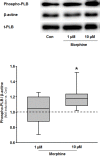Morphine-Induced Preconditioning: Involvement of Protein Kinase A and Mitochondrial Permeability Transition Pore
- PMID: 26968004
- PMCID: PMC4788451
- DOI: 10.1371/journal.pone.0151025
Morphine-Induced Preconditioning: Involvement of Protein Kinase A and Mitochondrial Permeability Transition Pore
Abstract
Background: Morphine induces myocardial preconditioning (M-PC) via activation of mitochondrial large conductance Ca2+-sensitive potassium (mKCa) channels. An upstream regulator of mKCa channels is protein kinase A (PKA). Furthermore, mKCa channel activation regulates mitochondrial bioenergetics and thereby prevents opening of the mitochondrial permeability transition pore (mPTP). Here, we investigated in the rat heart in vivo whether 1) M-PC is mediated by activation of PKA, and 2) pharmacological opening of the mPTP abolishes the cardioprotective effect of M-PC and 3) M-PC is critically dependent on STAT3 activation, which is located upstream of mPTP within the signalling pathway.
Methods: Male Wistar rats were randomised to six groups (each n = 6). All animals underwent 25 minutes of regional myocardial ischemia and 120 minutes of reperfusion. Control animals (Con) were not further treated. Morphine preconditioning was initiated by intravenous administration of 0.3 mg/kg morphine (M-PC). The PKA blocker H-89 (10 μg/kg) was investigated with and without morphine (H-89+M-PC, H-89). We determined the effect of mPTP opening with atractyloside (5 mg/kg) with and without morphine (Atr+M-PC, Atr). Furthermore, the effect of morphine on PKA activity was tested in isolated adult rat cardiomyocytes. In further experiments in isolated hearts we tested the protective properties of morphine in the presence of STAT3 inhibition, and whether pharmacological prevention of the mPTP-opening by cyclosporine A (CsA) is cardioprotective in the presence of STAT3 inhibition.
Results: Morphine reduced infarct size from 64±5% to 39±9% (P<0.05 vs. Con). H-89 completely blocked preconditioning by morphine (64±9%; P<0.05 vs. M-PC), but H-89 itself had not effect on infarct size (61±10%; P>0.05 vs. Con). Also, atractyloside abolished infarct size reduction of morphine completely (65±9%; P<0.05 vs. M-PC) but had no influence on infarct size itself (64±5%; P>0.05 vs. Con). In isolated hearts STAT3 inhibitor Stattic completely abolished morphine-induced preconditioning. Administration of Stattic and mPTP inhibitor cyclosporine A reduced infarct size to 31±6% (Stat+CsA, P<0.05 vs. Con). Cyclosporine A alone reduced infarct size to 26±7% (CsA P<0.05 vs. Con). In cardiomyocytes, PKA activity was increased by morphine.
Conclusion: Our data suggest that morphine-induced cardioprotection is mediated by STAT3-activation and inhibition of mPTP, with STA3 located upstream of mPTP. There is some evidence that protein kinase A is involved within the signalling pathway.
Conflict of interest statement
Figures






References
-
- Murry CE, Jennings RB, Reimer KA. Preconditioning with ischemia: a delay of lethal cell injury in ischemic myocardium. Circulation. 1986. November;74(5):1124–36. - PubMed
-
- Zhao Z-Q, Corvera JS, Halkos ME, Kerendi F, Wang N-P, Guyton RA, et al. Inhibition of myocardial injury by ischemic postconditioning during reperfusion: comparison with ischemic preconditioning. American Journal of Physiology—Heart and Circulatory Physiology. 2003. August 1;285(2):H579–88. - PubMed
-
- Cason BA, Gamperl AK, Slocum RE, Hickey RF. Anesthetic-induced preconditioning: previous administration of isoflurane decreases myocardial infarct size in rabbits. Anesthesiology. 1997. November;87(5):1182–90. - PubMed
-
- Müllenheim J, Ebel D, Frässdorf J, Preckel B, Thämer V, Schlack W. Isoflurane preconditions myocardium against infarction via release of free radicals. Anesthesiology. 2002. April;96(4):934–40. - PubMed
-
- Gross ER, Gross GJ. Ligand triggers of classical preconditioning and postconditioning. Cardiovasc Res. 2006. May 1;70(2):212–21. - PubMed
Publication types
MeSH terms
Substances
LinkOut - more resources
Full Text Sources
Other Literature Sources
Miscellaneous

